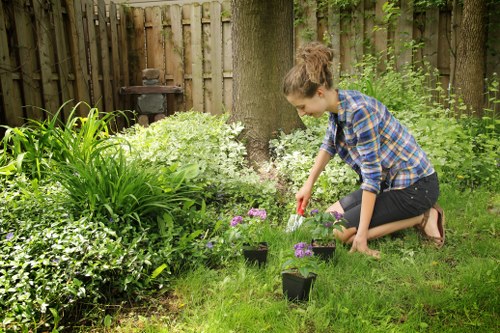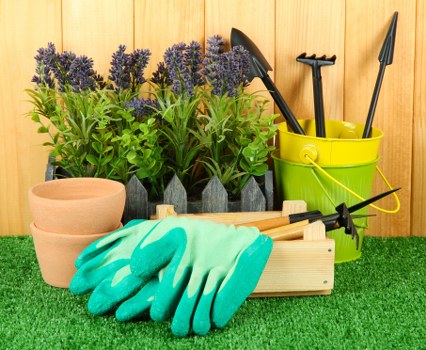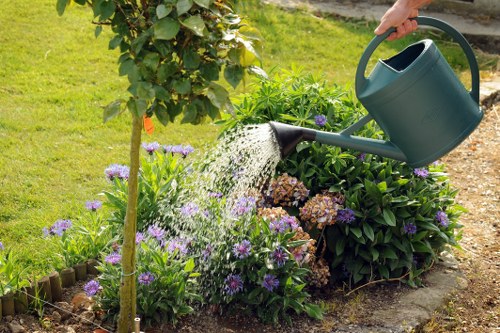Hedge Trimming Battersea

Introduction to Hedge Trimming in Battersea
Maintaining a beautiful garden requires regular care, and one essential aspect of this is hedge trimming. In Battersea, where gardens often serve as peaceful retreats from the bustling city life, keeping hedges well-trimmed not only enhances the aesthetic appeal but also ensures the health of the plants.
Hedge trimming involves cutting back the branches and stems of hedges to shape them and promote healthy growth. Whether you have tall, formal hedges or more informal, natural ones, proper trimming techniques are crucial.
In this article, we will explore the best practices for hedge trimming in Battersea, the benefits it offers, and why hiring a local expert can make all the difference.

The Importance of Regular Hedge Trimming
Regular hedge trimming provides numerous benefits for your garden. Firstly, it keeps your hedges looking neat and well-maintained, which can significantly improve the overall appearance of your property.
Moreover, trimming encourages healthy growth by removing dead or diseased branches, allowing more light and air to reach the inner parts of the hedge. This reduced clutter helps prevent pests and diseases from taking hold.
For those living in Battersea, where space might be limited, well-maintained hedges can also serve as effective barriers, providing privacy and defining different areas of your garden.

Best Practices for Hedge Trimming
Tools You’ll Need
To achieve the best results, having the right tools is essential. Here are some tools commonly used for hedge trimming:
- Pruning Shears: Ideal for smaller, detailed cuts.
- Hedge Trimmers: Perfect for larger areas and thicker branches.
- Loppers: Useful for cutting thicker stems.
- Safety Gear: Always wear gloves and protective eyewear.
Trimming Techniques
When trimming hedges, start by removing any dead or diseased branches. This not only improves the look but also promotes healthier growth. Next, shape the hedge by making even cuts to maintain a uniform appearance.
For a formal look, trim the sides straight and the top flat. For a more natural look, you can allow the hedge to keep some of its natural shape while still removing overgrown parts.

Timing Your Trimming
The best time to trim hedges in Battersea is during the late spring or early summer. This timing allows plants to recover quickly and continue growing throughout the season.
Avoid trimming during the winter months, as the cold weather can stress the plants and make them more susceptible to disease.
Regular trimming, typically once or twice a year, ensures that your hedges remain healthy and attractive.

Why Hire a Professional Hedge Trimming Service in Battersea?
While DIY trimming can be satisfying, hiring a professional service in Battersea offers several advantages.
Expertise and Experience
Professional hedge trimmers have the knowledge and experience to handle different types of hedges. They understand the specific needs of plants common in Battersea gardens and can ensure that trimming is done correctly.
Time-Saving
Trimming hedges can be time-consuming, especially for larger gardens. Professionals can complete the job efficiently, freeing up your time for other activities.
Safety
Using heavy or sharp tools can be risky. Professionals are trained to handle equipment safely, reducing the risk of accidents.
Costs of Hedge Trimming in Battersea
The cost of hedge trimming services in Battersea can vary based on several factors, including the size of your garden, the type of hedges, and the extent of trimming required.
On average, residents can expect to pay between £50 and £150 for a standard hedge trimming service. It's advisable to obtain quotes from multiple providers to ensure you receive a fair price.
Maintaining Your Hedges Between Trims
To keep your hedges healthy and reduce the need for drastic trimming, regular maintenance is key.
- Watering: Ensure your hedges receive adequate water, especially during dry periods.
- Fertilizing: Use appropriate fertilizers to promote healthy growth.
- Pest Control: Monitor your hedges for signs of pests or diseases and address them promptly.
- Weeding: Keep the base of your hedges free from weeds to reduce competition for nutrients.
Environmental Benefits of Hedge Trimming
Properly trimmed hedges contribute positively to the environment. They provide habitats for various birds and insects, promoting biodiversity in urban areas like Battersea.
Healthy hedges also act as natural barriers against noise and air pollution, creating a more pleasant living environment for residents.
By maintaining your hedges, you support local ecosystems and contribute to the overall greenery of the community.
Choosing the Right Hedge Trimming Service in Battersea
When selecting a hedge trimming service, consider the following factors:
- Reputation: Look for reviews and testimonials from previous clients.
- Experience: Choose a service with extensive experience in hedge trimming.
- Insurance: Ensure the company is insured to cover any potential damages.
- Pricing: Compare quotes to find a service that fits your budget.
- Availability: Select a service that can accommodate your scheduling needs.
Local Regulations and Considerations
In Battersea, there may be local regulations regarding hedge trimming, especially if your garden borders public spaces or neighboring properties.
Before undertaking any trimming project, familiarize yourself with these regulations to ensure compliance. Professional services are typically well-versed in local laws and can guide you accordingly.
Case Studies: Successful Hedge Trimming in Battersea
Residential Gardens
Many Battersea residents have transformed their gardens with regular hedge trimming. For instance, a family in South Battersea saw their overgrown hedges reshaped into elegant borders, enhancing their garden's overall look.
Commercial Properties
Businesses in Battersea also benefit from professional hedge trimming. A local café improved its curb appeal by maintaining neat hedges, attracting more customers and creating a welcoming atmosphere.
Common Mistakes to Avoid
While trimming hedges, avoid these common mistakes:
- Over-Trimming: Cutting too much can stress the plant and hinder growth.
- Incorrect Timing: Trimming at the wrong time of year can negatively impact the health of your hedges.
- Using the Wrong Tools: Using dull or inappropriate tools can damage the plants and result in uneven cuts.
- Neglecting Regular Maintenance: Inconsistent trimming can lead to overgrown hedges that are harder to manage.
Seasonal Hedge Trimming Tips
Spring
Spring is an ideal time to trim your hedges as it promotes healthy growth. Remove any winter damage and shape the hedges before the growing season begins.
Summer
Trimming in early summer helps maintain the desired shape and prevents hedges from becoming too dense. Ensure they receive adequate water after trimming.
Autumn
Avoid heavy trimming in autumn as it can stimulate new growth that may not harden before winter. Focus on light maintenance instead.
Winter
Winter trimming is generally discouraged, but light pruning to remove dead branches is acceptable if necessary.
Innovative Techniques in Hedge Trimming
Advancements in gardening tools and techniques have made hedge trimming more efficient. Electric and battery-powered trimmers reduce manual effort, while robotic hedge trimmers are becoming popular for their convenience.
Additionally, sustainable practices, such as using organic fertilizers and eco-friendly tools, are gaining traction in Battersea, promoting environmentally responsible gardening.
Conclusion
Hedge trimming plays a vital role in maintaining a beautiful and healthy garden in Battersea. Whether you choose to undertake the task yourself or hire a professional service, understanding the best practices and benefits is essential.
By keeping your hedges well-trimmed, you not only enhance the visual appeal of your property but also contribute to a healthier environment. Investing time and care into hedge maintenance ensures that your garden remains a serene and attractive space for years to come.
Frequently Asked Questions
1. How often should I trim my hedges in Battersea?
Generally, hedges should be trimmed once or twice a year. The best times are in late spring and early summer to promote healthy growth.
2. Can I trim my hedges myself, or should I hire a professional?
While small hedges can be trimmed by homeowners, larger or more complex hedges may require professional expertise to ensure proper care and safety.
3. What tools do I need for hedge trimming?
You will need pruning shears, hedge trimmers, loppers, and safety gear such as gloves and protective eyewear.
4. Are there specific regulations for hedge trimming in Battersea?
Yes, there may be local regulations, especially if your hedge borders public areas or neighbors. It's important to check with local authorities or hire a professional familiar with local laws.
5. What are the signs that my hedges need trimming?
Signs include overgrowth, uneven shape, lack of air circulation, and visible dead or diseased branches. If your hedges are blocking sunlight or impeding movement, it's time to trim them.
Frequently Asked Questions
Get In Touch With Us.
Please fill out the form below to send us an email and we will get back to you as soon as possible.